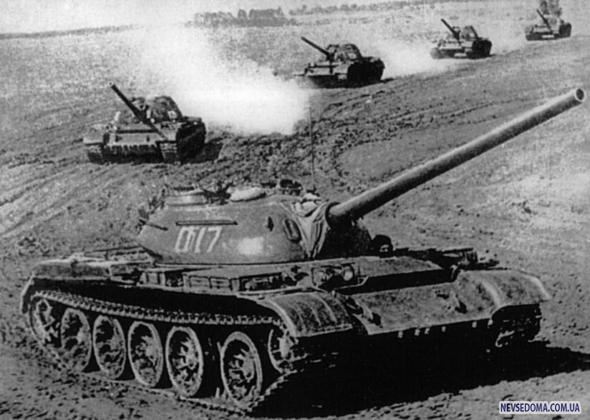Options for upgrading the T-55 tank (15 photos + description)

T-54 is a Soviet medium tank. Adopted by the Soviet Army in 1946, it has been mass-produced, constantly modernized, since 1947. Since 1958, a modification called the T-55 has been produced, adapted for combat operations in conditions of the use of nuclear weapons. In 1962-1967, it was mainly replaced in production by the T-62 tank, created on its basis, but its production at OZTM continued until 1979. Also in a number of countries, the T-54/55 itself, or its modernized or adapted to local conditions, versions were produced. In total, taking into account variants produced in other countries, up to 100,000 T-54/55 were produced, making it the most numerous tank in history.
Many countries that still have old Soviet tanks in service have modernized them to meet today's requirements.
First, let's look at the question - why is all this needed? Isn't it easier to just melt down an old tank and make a new, modern one? Maybe 15-25 years ago they would have done this, but now it would be the height of waste. The fact is that the bulk of the tank is made up of armor, which, as is known, consists of armor steel. If the tank hull is melted down, you will no longer have armor steel at the output; at best, just steel, or even cast iron. Next, you will need to obtain armor steel in a new way, but taking into account today’s prices for energy resources and minerals (in the production of armor steel, a huge amount of alloying additives - ferroalloys) is used, it will truly become worth its weight in gold, and there are tens of tons of it in the tank.
Taking into account the above trends, an urgent, and most importantly, economically justified need arose to modernize existing outdated tank models.
Tank TR-85M1 Bizonul (Bison). Romania

At first glance at the photo of this machine, you get the impression that this is an absolutely independent development. Both the name and appearance spoke volumes about it. However, this is just the deepest modernization of our T-54/55.
This modernization project began in 1995. According to this project, no less than 300 vehicles were modernized. This tank really has a lot of differences from the original.

It has a completely different engine - diesel 8VS-A2T2, with a power of 860 hp. With this engine, the car accelerates to 60 km/h. By the way, it was this engine that was installed on the German Leopard 1 tank. The vehicle’s suspension was completely redesigned to take into account the increased weight. By the way, the weight of the car has become as much as 54 tons.

The car's gun remained Soviet, but a stabilizer was installed for it in all planes. Also, as can be seen from the photo, it is covered by a thermal casing. The tank is equipped with a laser irradiation warning system with automatic firing of smoke grenades. The turret, as can be seen from the photo, has the most serious alterations, and initially a 120 mm NATO smooth-bore gun was supposed to be installed in it. But something didn’t work out there, and they left our well-deserved gun. The vehicle's ammunition capacity is 41 rounds. The gun is loaded manually. Naturally, the vehicle has all the latest tank sighting devices. All this was supplied by the famous French company Matra. The machine gun armament of the vehicle is no different from the original - T-55, a coaxial 7.62 mm machine gun and a 12.7 mm anti-aircraft machine gun.

By the way, the modernization project was truly multinational, with a huge number of companies from all over Europe participating in it. But the main contribution, nevertheless, was made by the French from Matra.
Among the innovations in protection systems, it is necessary to note the active armor that has already become traditional for modernized vehicles. True, its area is not as large as, for example, its Slovenian counterpart.

Now a little about prices. According to the Romanians, modernization cost them about 1 million per car. Which is 10-15% of the cost of a new one, so it makes sense.
Slovenian version of the modernization of the T-55 tank

Slovenia has carried out the most profound modernization of the honored old man T-54/55. This modernization was carried out jointly by the Slovenian company STO RAVNE and the Israeli Elbit. During these works, 30 vehicles were modernized. The last updated T-55 was transferred to the Slovenian armed forces in 1999.

During the modernization the following changes were made. A new 105 mm gun with a thermal shroud was installed. The tank was equipped with active armor, its elements are clearly visible on the hull and turret. The fire control system was improved by installing a digital ballistic computer. The gun is stabilized in two planes. A new Fotona SGS-55 sight with a laser rangefinder was installed. The vehicle was also equipped with a Fotona COMTOS-55 commander's sight with an independent stabilization line of sight, which allows him to track targets and even aim the gun independently of the gunner, if necessary. The LIRD-1A Laser Illumination Detector is linked to the IS-6 smoke grenade launcher system which can be automatically activated in the event of an emergency.

Upgrades to the V-12 diesel engine resulted in an increase in power from 520 hp. up to 600 hp Currently, the possibility of replacing this engine with a German MAN with a power of 850 hp is being considered.
Rubber side skirts appeared in the chassis, and the tank was also equipped with new rubber-metal tracks.
An additional niche has appeared at the rear of the tower, but what is installed there is unknown.

Tank Jaguar (Jaguar)
Looking at this vehicle, you would never guess that this is not an independent development, but just a variant of the T-54/55 modernization. If there was a competition for the most beautiful modification (tuning is even suitable for this car), then it would probably win with a clear advantage.

But let's get back to the project itself. This project was prepared jointly by two American companies Textron Marine and Land Systems. Cadillac Gage Textron was selected as the contractor for the production of this project. This project provided for the modernization of our T-54/55 and Chinese Type 59 tanks, which, both ours and the Chinese, managed to distribute throughout the world. The project was announced back in 1997, but until now there have been no people willing to order this tank. Only two cars were produced. Apparently, this is due to the price of such an upgrade, which will cost about $2.8 million.
So, what changes, besides appearance, will the T-55 have?
First, this is the engine - diesel engines from the Detroit Diesel Corporation with a power of 750 hp will be installed on the car. With this engine, the tank reaches a speed of 55 km/h.
This car must be equipped with a gearbox from Allison Transmission, which is part of the General Motors concern. The gearbox, as you might guess, is automatic.
It was planned to install two suspension options on the car. A cheaper option is a regular torsion bar. If necessary, the car can be equipped with Cadillac Gage Textron hydropneumatic suspension.
The vehicle should be armed with a NATO 105 mm rifled gun. No changes are envisaged in machine gun armament.
Everything about the fire control system is pretty standard. The gun is stabilized in all planes. A laser range finder is provided.
The weight of the vehicle will be in the range of 42-46 tons, depending on the configuration.
P.S. Automotive standards were transferred to the tank. But apparently nothing good came of this.
Tank T-55AGM. Ukraine.

Kharkov residents offered several modernization options at once, as they say, to satisfy any desires of customers.


So, the tank has undergone a deep modernization of the fighting compartment, which will allow the installation of a 125 mm KBM1 or 120 mm KBM2 gun (upgraded KBM1 for NATO ammunition) at the request of customers. This gun can fire both conventional shells and ATGMs, which makes it possible to confidently hit modern MBTs at distances of up to 5000 meters.


The vehicle has an automatic loader installed in the rear of the turret in the armored compartment. Thanks to this, the number of crew members in the tank was reduced to 3 people. The automatic loader also made it possible to increase the vehicle’s rate of fire to 8 rounds per minute. The machine gun armament is standard, a 7.62 mm coaxial machine gun and a 12.7 mm anti-aircraft machine gun, however, depending on the order, machine guns can be installed from ours or from NATO countries.

The modernized T-55AGM tank is equipped with a modern fire control system, which ensures that the gunner and commander can fire at stationary and moving targets from a standstill and on the move with a high probability of hitting with the first shot.
The fire control system consists of a 1K14 gunner's day sight, a PTT-M thermal imaging sight with a SAGEM MATIS thermal imaging camera, a PNK-4S commander's sighting and observation system, a PZU-7 anti-aircraft sight, a 1ETs29M anti-aircraft gun control system, and a LIO-V ballistic computer with sensors input information, weapon stabilizer 2E42 and other devices. The 1K14 gunner's day sight has a line of sight stabilized in two planes, a built-in laser rangefinder and a guided missile control channel. It implements automated compensation for gyroscope drift. The sight's field of view has a magnification of 10x.

The built-in laser rangefinder provides target range measurement up to 9990 meters and has an accuracy of up to 10 meters. The measured range is displayed along with the readiness to fire signal and the type of ammunition in the lower part of the field of view of the gunner's sight.
The PTT-M thermal imaging sight includes an optoelectronic gunner's device, a monitor and a commander's control panel. The thermal imaging sight allows the gunner and commander to detect targets and fire (the commander in duplicate fire control mode) at them in almost any weather conditions at long range and with high accuracy, which is a big advantage when working in poor visibility conditions, as well as in the dark days. The thermal scope also allows you to ignore some common obstructions such as battlefield smoke.

The PNK-4S commander's sighting and observation system consists of a TKN-4S commander's combined day-night sight and a gun position sensor. The commander's combined sight TKN-4S has a line of sight stabilized in the vertical plane and three channels: a day single channel, a day multiple channel with a magnification magnification of 7.6x, and a night channel with a magnification magnification of 5.8x.
The anti-aircraft sight allows the commander to fire at air targets from an anti-aircraft machine gun mount while being protected by the turret's armor.

The LIO-V digital ballistic computer for calculating ballistic corrections automatically takes into account signals coming from the following sensors:
? tank speed
? target angular velocity
? roll angle of the gun trunnion axis
? transverse component of wind speed
? range to target
? heading angle
Additionally, for the calculation, the following parameters are manually entered: ambient air temperature, charge temperature, barrel bore wear, ambient air pressure, etc.

The turret drive is electric, and the gun drive is hydraulic. In case of an emergency, manual drives for pointing the gun and turret are provided.
A special feature of the tank is the presence of guided weapons, which allows the cannon to fire laser-guided missiles and hit targets with a probability of at least 0.8 at a range of up to 5000 m. Guided weapons also provide the tank with the ability to hit helicopters hovering over the battlefield, firing from inaccessible for conventional tank weapons distances.

The missile can be fired in motion at a moving target. The missile has a tandem warhead, which allows it to hit targets equipped with dynamic protection, as well as modern multi-layer armor, which has improved characteristics for protection against cumulative ammunition.
A machine gun paired with a cannon can be fired from the gunner's or commander's position at stationary targets, such as buildings and bunkers.

The power plant proposed for installation in modernized tanks is developed on the basis of the 5TDFM engine with a power of 850 hp. This power plant is structurally and technologically made in the form of a separate module, welded in place of the cut-off aft part of the hull. The specified engine is a two-stroke multi-fuel diesel engine with direct-flow purge, liquid cooling, with horizontally arranged cylinders and counter-moving pistons.

The engine runs on various types of fuel: diesel, gasoline, kerosene, jet fuel or a mixture of them in any proportion.
Power is taken from both sides of the crankshaft. The engine is mounted using two cylindrical supports (yokes), coaxial to the power take-off shaft and located at the ends of the engine, and a front support located on the lower surface of the engine. This method of engine mounting does not require adjustment and alignment operations when installing the engine in the MTO, unlike the standard version of the tank.
The main features of the power plant with the 5TDFM engine are an ejection cooling system, a highly efficient air purification system entering the engine, the presence of a special air intake device for fording depths of up to 1.8 m and high tightness of the MTO.
The cooling system is liquid, closed, forced, ejection type. The cooling system ejector operates on engine exhaust gases. The absence of a fan and drive gear significantly reduces the weight of the cooling system, provides a high level of reliability and self-regulation, and ensures operation of the tank without restrictions at high temperatures. A highly efficient cyclone-cassette air cleaner ensures air purification from dust by 99.8%.

After modernization, the following tank parameters are provided:
? increase in average speed on dirt roads by 22%;
? ensuring operation at ambient temperatures up to + 55°C;
? ensuring the operation of tanks in dusty conditions before servicing cassettes for 35 operating hours or 1000 km;
? providing fording without preparation up to 1.8 m.
These differences ensured an increase in the mobility and controllability parameters of the T-55 AGM tank in comparison with the T-55:
? the maximum forward speed on paved roads has increased to 65 km/h instead of 50 km/h (by 30%)
? 5 reverse gears made it possible to increase the rollback speed to more than 30 km/h instead of 6 km/h (5 times)
? Unlike the T-55 tank, which provides a minimum turning radius in 1st gear only around the braked track, the motion control system of the T-55AGM tank allows turning both around the braked track and around the tank axis, depending on the amount of movement of the steering control.

Driver's department of the modernized T-55AGM tank. It can be seen that a steering wheel is installed instead of control levers
The additional protection complex for the T-55AGM tank (KDZ) is designed to increase the level of protection of the tank from cumulative and kinetic (armor-piercing sabot projectiles - BPS) weapons with the minimum possible increase in the tank's weight. The KDZ consists of passive armor protection and built-in dynamic protection (EDP).

A removable module is installed on the nose of the tank hull. Power screens and rubber-fabric shields are installed on the sides. Along the outer perimeter of the frontal and side sections of the tower there are modular sections, as well as containers installed on the roof of the tower. New generation dynamic protection elements of the “Knife” type are installed inside each section of the airborne protection and each container.

The protective effect of EDS on a cumulative agent is based on the destruction, fragmentation and change in the direction of the cumulative jet due to the impact of EDS parts and detonation products of the explosive located inside the EDS and initiated by the cumulative jet.

The protective effect of the explosive protection on a kinetic projectile is based on the destruction of its body and a change in the direction of its penetration due to the impact of the detonation products of the explosive located inside the dynamic protection element (EDS) and initiated by the kinetic energy of the projectile. Installing a VDZ increases the level of protection of the T-55AGM tank:
? from cumulative destructive agents - 2.3...2.6 times;
? from kinetic destructive agents - 3.5...4.3 times.
Dynamic protection elements (EDP), which are part of the EPP, do not detonate when hit by bullets from small arms and automatic weapons of 7.62 mm, 12.7 mm caliber, and automatic gun shells of up to 30 mm caliber, as well as from exposure to incendiary mixtures such as napalm and damaging factors of volumetric explosion.

In order to improve the protective characteristics of the T-55AGM tank, it is proposed to use an aerosol curtain system (ACS) in its composition. The system for setting up an aerosol curtain is designed to suppress ATGM control systems that use laser illumination of targets and heads with semi-active laser homing, as well as artillery systems with laser rangefinders, by detecting laser radiation, determining its direction and remotely setting up rapidly forming aerosol curtains.
BMPV-64 heavy infantry fighting vehicle. Ukraine.

The prototype of the BMPV-64 heavy armored personnel carrier was developed in Ukraine as a private initiative of the Kharkov BTRZ. The first prototype was completed in 2005. This vehicle represents the deepest modernization of the well-deserved T-64 MBT. The Ukrainian army has several thousand of these tanks. BMPV-64 is designed to transport and support infantry. The vehicle was created taking into account the experience of infantry fighting vehicles operating in urban environments, or rather their unsuccessful actions due to catastrophically insufficient armor. It was during urban battles that these shortcomings were revealed, since according to the tactics of using infantry fighting vehicles during conventional military operations, they must go behind tanks, and their function was reduced only to the function of delivering infantry to the point of attack. But in urban battles, where the enemy’s line of defense is blurred and an attack can be expected from any direction and from any house, infantry fighting vehicles often find themselves on the front line, where they suffer heavy losses.

BMPV-64 has composite armor which is supplemented with dynamic armor blocks. The lower part of the hull was also strengthened compared to the T-64 tank, to a level at which the BMPV -64 could survive a 4 kg anti-personnel mine explosion. In addition, a heavy armored personnel carrier can be equipped with an active protection system - Zaslon. It is claimed that this armored personnel carrier has protection no worse than that of most tanks.

The BMPV-64 engine is located at the front. The designers actually made the front part of the vehicle behind the tank body, so this heavy armored personnel carrier, so to speak, rides backwards, compared to the T-64. The front engine location provides additional protection and provides enough space to accommodate troops.

For landing and landing of troops, the armored personnel carrier is equipped with convenient doors in the rear part of the hull. This favorably distinguishes this development of Kharkov tank builders from competitors both in Ukraine and in Russia. Unlike the KMDB specialists, the designers of the Kharkov Armored Repair Plant did not try to combine incompatible things - a tank and an armored personnel carrier, resulting in a poorly applicable design that did not fully perform the functions of either one. The Ukrainian vehicle compares favorably with Russian heavy armored personnel carriers (BMO-T, DPM-72) in that it has a larger troop compartment capacity and significantly better conditions for landing and boarding the vehicle.

The prototype of this heavy armored personnel carrier is equipped with a remotely controlled combat module, which is armed with a 30 mm cannon and a coaxial 7.62 mm machine gun. The vehicle is also equipped with one remote-controlled 12.7 mm machine gun.

The BMPV-64 engine uses a proven 5TDF multi-fuel diesel engine, developing a power of 700 horsepower. The car is also offered with a Ukrainian 6TD diesel engine, developing 1,000 horsepower. With this engine, the car can reach speeds of up to 75 km/h.

Various versions of this infantry fighting vehicle are offered, such as a command vehicle, self-propelled guns for a 120-mm mortar, evacuation vehicle and others. Such great modernization opportunities are made possible by installing various combat modules weighing up to 22 tons on this vehicle. In its basic version, the BMP weighs 32.5 tons. In the basic version, the vehicle can easily accommodate up to 12 paratroopers and 3 crew members.

This vehicle is planned to be adopted by the Ukrainian Army in 2010, and in the future it should replace the existing BMP-1 and BMP-2. Due to complete unification with the T-64 tank, this BMPV-64 will be much easier to introduce into the Ukrainian army and facilitate the process of creating a material and technical base and training personnel.
Brief technical characteristics of BMPV-64;
Crew: 3 people
Troops: 12 people
Weight: 32500 kg
Engine power: 1000 hp
Maximum speed: 75 km/h
Cruising range (on highway): 800 km
You must register to read the text
Heavy infantry fighting vehicle BMPT-K-64. Ukraine.

The Kharkov Armored Repair Plant developed and manufactured a wheeled infantry fighting vehicle at the experimental level, in which the hull and engine of the T-64 tank were used as the hull and engine. Choosing a hull made from medium-hard armor has other advantages. After a large amount of welding work, such a hull does not deform and its thermal straightening, as is the case when using fragile high-hardness armor of modern armored personnel carriers, is technologically unnecessary. All this significantly simplifies and reduces the cost of manufacturing the body of a heavy wheeled infantry fighting vehicle, called BMPT-K-64.

Feature: tank-level protection, i.e. on board protection against 30 mm automatic guns and RPGs (with remote sensing).
Despite the use of a wheeled chassis, the vehicle is controlled “like a tank.” The design of the wheel drive, however, is unknown.

Brief technical characteristics of BMPT-K-64
The weight of the vehicle (without weapons) is 17.7 tons.
Dimensions - 6.0X3.1X1.9.
Board - 82 +20
Feed - 40
Nose - 270-300
The height of the landing compartment is 1.3 m.
Landing party - 8 (+2-3 crew)
Speed - 105 km/h.
Power reserve - 800 km.
How are such machines made?
As you can see, first they take an old Soviet T-64 tank and completely dissect it. The technology is not God knows how modern, but the result...

To obtain the BMPT-K-64, a similar procedure is performed with the T-55 tank.

Next, the engine is reinstalled. The engine is usually not new, but a completely rebuilt old 5TD diesel engine. Please note that the design is not radically redesigned, the engine is installed in the same place where it was in the tank, only in the BMPV-64 it is in the front, since it is essentially a tank that drives backwards to the front. This, by the way, is the main feature of the Ukrainian car. Before the Kharkovites, no one could come to such a simple, and I’m not afraid of this word, ingenious engineering solution. Other heavy armored personnel carriers drive the same way as their ancestors, and this raises the problem of paratroopers leaving the fighting compartment. Since the engine is located at the rear, they have to squeeze back, as in the Achzarit, or even go out on top of the vehicle, under enemy fire, as on the BTR-T. The Ukrainian car does not have this drawback. The exit doors for infantrymen are wide and spacious, and infantrymen can quickly leave the armored personnel carrier.

But let's return to the BMPV-64. As you can see, the troop compartment is being welded in a new way behind the engine compartment. By the way, armor plates from old tanks are also used for this.

Well, at the end there is, so to speak, finishing work, equipping the troop compartment, installing weapons, installing active armor and painting. And, voila, the heavy armored personnel carrier is ready.

I would like to note that the weapons on the BMPV-64 and BMPT-K-64 are not located in the turret, but, as is now fashionable, in an uninhabited combat module. For these vehicles, several variants of such modules have been developed, which will consist of both a small-caliber rapid-fire cannon and a large-caliber machine gun, all of these firearms have various combinations with various missiles, anti-tank and anti-aircraft, as they say, combat modules have been designed for every taste.
It should be noted that initially the machines were aimed exclusively at export. Kharkov residents did not count on their purchase by the Ukrainian army.
But in principle, there are no technical problems in converting, thus, any tank. For example, Ukrainian engineers helped the Jordanians convert the English Centurion tank (meaning Temsah) into an armored personnel carrier.






















